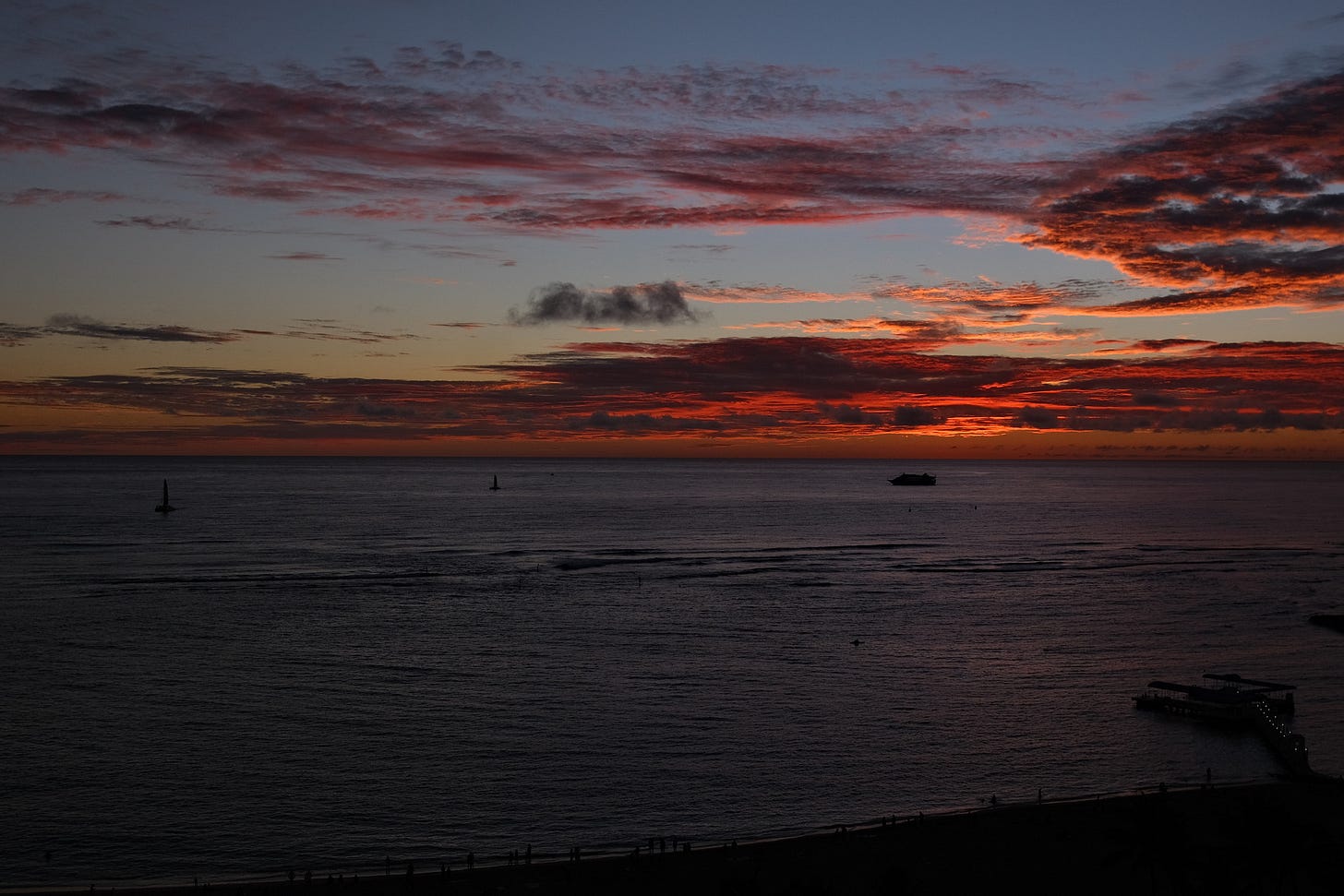
This is one view of the Pacific Ocean, looking westerly in Honolulu as the sun set back in late September. Things were remarkably welcoming as rich colours poured across the sky, signalling it was time to settle down for another evening of music, or camraderie, or anticipation of another day.
Hawai’i sits at a point in the Pacific where few hurricanes affect its joyful lifestyle. Tremendous downpours plagued O’ahu in early 2022, creating substantial flooding but the island dried out later in January so the damage was manageable.
The volcanos undergirding and creating the islands blend in to nature’s glory, predominantly asserting themselves when a periodic eruption on the Big Island leads to lava flows forcing people to change their plans. Indeed, the volcanos draw tourists who have a relatively nearby view of lava oozing close to people’s homes in some cases. The Volcanos National Park educates thousands annually, retelling the history of these islands’ birth in the middle of the Pacific. Hawai’i has few notable earthquakes in conjunction with the volcanic activity.
Contrast this with seemingly endless major natural disasters plaguing to two states on the other side of the same ocean: the Philippines and Indonesia. Manila’s need to address a massive typhoon stresses the emergency response every year. Category 5 Haiyan in November 2013 was one of the most powerful cyclones ever recorded, following on the heels of a 7.2 magnitude earthquake the previous month. The Philippine government responds to roughly twenty typhoons annually. These numbers for a less than wealthy country are astonishing but unavoidable events in a geographically challenged area.
Indonesia, similarly, sits to the south of the Philippine archipelago. This nation woven together from more than 17,000 islands regularly feels massive earthquakes such as the 7.2 magnitude tremor that hit yesterday on the densely-populated main island of Java. A shallow earthquake, the devastation led to 268 recorded deaths but many injuries resulting from the collapse of structures in a vast swath of the island south of the capital Jakarta. Indonesia, like the Philippines, has an active volcano band resulting from the island nation’s location on the western rim of the Pacific on the so-called ‘Ring of Fire’. Indonesia mercifully does not confront as many typhoons as the Philippines but its natural disasters are ever bit as severe.
Both of these nations, like virtually all of the Pacific, also keenly see the immediate and serious affect of rising sea levels resulting from global warming. For states in this region, threats to lifestyles affected by global warming are profoundly affecting the seaside cultures of these nations with ripple effects into other aspects of their societies.
The governments of these states struggle to provide relief as many of nature’s events most affect those in rural, remote areas with limited access. The makes rescue and recovery expensive, time-consuming, and frustrating for those affected. Yet, governments have no option but to work on their humanitarian assistance and disaster relief (HA/DR) operations. One of the greatest tools that foreign governments such as the United States, Australia, or even China offer these states is steady continued cooperation to improve HA/DR skills as the inevitability of the need for that support is clear. HA/DR capabilities are an on-going need in much of the western Pacific regularly.
Any natural disaster is terrible when one is afflicted. In the United States we have the ones discussed, along with droughts, wildfires, and crippling snowstorms (cue Buffalo). The difference is we have the resiliency to address these challenges in a way most other states do not. That does not mean they are not expensive for us; they are. But, we have capabilities to mobilise more immediately than many other countries do. We should never take this for granted nor should we allow those capabilities and further exploration of improvements in building codes, for example, to cease; we need to push the boundaries to strengthen protections against natural disasters everywhere.
We also need recognise that our generosity, so often maligned of late as naive, is in fact one of our greatest strengthens. People in the Philippines remember what support the U.S. Agency for International Development provided in 2013. The earthquake assistance the United States provides this week to assist Jakarata’s search and rescue, redevelopment, and other activities will leave a memory for Indonesians. We are foolish to assume others do not appreciate us as they do. Their primary concerns at any moment, however, may be survival instead of thanking us. We give generously with out demanding payback which is not true from our Chinese counterparts, for example.
Hawai’i as the sun sets is one of the most magical places in the world. The Pacific is a backdrop of unparalleled beauty. But, not everyone has the geographic advantage the Hawai’ian islands have. That unparalleled beauty can provide real survival challenges over the horizon. FIN




Janet, thank you for this. I am NOT in any way saying we are completely ready for problems. I apologise if i sounded that way. I am well aware we have not responded to wildfires as well as we could. But, we have more resilience than others, I think. I have read the descriptions of what we will have (and it is a certainty) when we have a tsunami or earthquake on the Pacific rim. It is an ugly scenario. Thank you for this, however.
Yes, we all think it won’t happen but, of course, there is an inevitability involved. I meant resilience in that we have resources to regroup. I do Do wonder the same thing you asked: why DO people still live there or in the Colorado River basin/ so Cal with fires and less water.